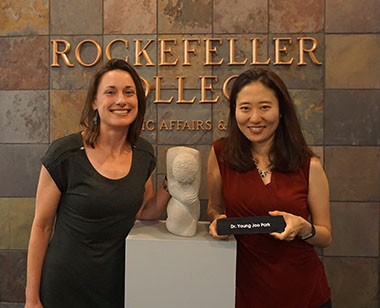Location Matters
 |
|
Associate Professor of Public Administration & Policy Erika Martin and Young Joo Park following Park's successful dissertation defense. Photo by Kiwoong Park.
|
ALBANY, N.Y. (December 1, 2017) – New findings by a UAlbany research team suggests that nursing homes located in minority neighborhoods and with more low-income patients have notably lower quality of care and worse fiscal stress.
Young Joo Park, a newly minted Public Administration & Policy PhD and current fiscal analyst at the Rockefeller Institute of Government, and Erika Martin, associate professor of Public Administration & Policy, have a particular research interest in health policy, including institutional healthcare disparities.
The duo noted that inequalities in long-term care in the United States have been an understudied but critical issue: by 2029, more than 20 percent of the U.S. population will be over 65 years old. Despite the growing popularity of home and community-based services, 35 percent of those turning 65 are expected to move to institutional nursing facilities.
Nursing homes aren’t immune to financial and operational problems that cause them to completely shut down; 16 percent of U.S. nursing homes closed between 1999 and 2008. Of these closures, a disproportionate number were located in neighborhoods with a high concentration of racial and ethnic minorities and poverty. Because location is the single most cited priority in nursing home selection, a closer look was warranted at the complex issue of nursing home care in geographic areas with high concentrations of poverty and minorities.
The pair set out to answer two primary questions:
- Do nursing homes serving predominately low-income and racial minority residents have worse financial outcomes and care quality?
- Do nursing homes located in neighborhoods with high concentrations of low-income and racial minority residents have worse financial outcomes and care quality?
Park and Martin designed a cross-sectional study to identify the relationship between factors on nursing home financial stress and quality of care. They merged multiple datasets obtained from Centers for Medicare & Medicaid Services and the U.S. Census Bureau, such as the Skilled Nursing Facility Cost Report, the Nursing Home Five-Start Quality Rating System, the Online Survey Certification and Reporting, and the American Community Survey.
After merging the datasets, Park and Martin used hierarchical linear modeling to dive further into the financial stability and “quality rating score” (a score between 10-50 that takes into account measures such as whether a nursing home is in compliance with federal requirements, how many hours qualified nurses and staff work per day, whether percentage of residents whose level of need has increased, etc.) of approximately 9,800 nursing homes.
Their analysis found the following:
- Medicaid-dependent nursing homes have higher levels of fiscal stress than their non-Medicaid dependent counterparts; this indicates that nursing homes’ geographic location may exacerbate long-term care inequalities.
- A 1% increase in the neighborhood population living in poverty is associated with a 1.20-point lower quality rating.
- Those serving primarily racial minorities have a 2.64-point lower quality rating score
- A 1% increase in the population of neighborhood black residents is associated with a 0.8% lower operating ratio and a 0.37 lower quality rating.
“I found it quite interesting that the physical and social environment of neighborhoods is directly related to access to financially viable and high-quality long-term care institutions,” said Park. “As a quantitative researcher, I really enjoy using analysis and writing to disseminate research to those beyond the academic community, including policy makers, who can take action based on findings,” she continued.
“This study is unique because although existing social epidemiology literature evaluates geographical determinants of population health, it does not focus on institutional outcomes, and the health services and public finance literatures examine determinants of institutional outcomes but have not commonly explored neighborhood effects,” said Martin. “This project is a perfect example of how UAlbany’s Rockefeller College students are able to take interdisciplinary approaches to understand important policy issues.”
The full paper, which was part of Park’s PhD dissertation and presented at the American Society for Public Administration conference, was published in Health Services Research, one of the top journals in the field. The full paper can be downloaded here.
![]() For more news, subscribe to UAlbany's RSS headline feeds
For more news, subscribe to UAlbany's RSS headline feeds
A comprehensive public research university, the University at Albany-SUNY offers more than 120 undergraduate majors and minors and 125 master's, doctoral and graduate certificate programs. UAlbany is a leader among all New York State colleges and universities in such diverse fields as atmospheric and environmental sciences, business, education, public health,health sciences, criminal justice, emergency preparedness, engineering and applied sciences, informatics, public administration, social welfare and sociology, taught by an extensive roster of faculty experts. It also offers expanded academic and research opportunities for students through an affiliation with Albany Law School. With a curriculum enhanced by 600 study-abroad opportunities, UAlbany launches great careers.


